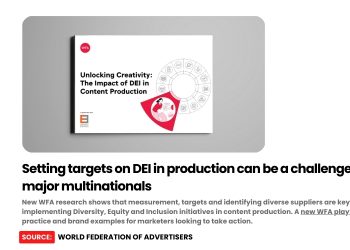Multinational brands are planning to increase their spending on influencer marketing in the next 12 months, with 65% aiming to spend more, according to new research from the WFA. The goal of such investment is primarily to boost brand awareness (86%) but influencers are also used to reach targeted/new audiences (74%) and to improve brand advocacy (69%). However, despite their willingness to invest more, marketers will only do so where standards on transparency are met. Credibility, reputation, and quality of followers are at the top of their selection list when they decide who to work with. The top criteria for multinational brands were quality of followers, cited as “absolutely essential” or “very important” by 96% of respondents. Similarly, the credibility and reputation of the influencer were also critical for the vast majority, scoring 93% on the same measure.
Marketers’ transparency concerns also extended into the way that the relationship is declared to consumers, with 71% saying the way the relationship is disclosed was an “absolutely essential” or “very important” part of the selection process. The findings are based on a survey of 34 companies representing 15 categories and approximately $59 billion in global media and marketing spend. All respondents use influencers to market their products online, with 54% doing so “only occasionally / in some markets” and 46% using them “very often”. The research aims to provide a benchmark for the current state of influencer marketing and the degree to which big brands have policies and processes in place to manage these new channels.
The WFA will now work with members such as Unilever, which has been outspoken about the need for influencers to behave ethically, to use this research as the starting point for the creation of best practice guidance to ensure that brands of all sizes are able to make the most of the influencer space.
Brands had a multitude of models for making that declaration with hashtags, descriptions in the post/video, paid partnership labels or a verbal mention being used always or very often by 68%, 63%, 43%, and 50% respectively. A variety of payment models have also evolved, with the two most used being a flat fee per post/video or offering free products/services for posts. The former is used always or very often by 66% and the latter by 62%. Other models being used include a fee based on performance (12%), no payment but free products to test (25%) or free products where performance warrants (11%).
“Influencer marketing is becoming a key channel for many marketers but it will only be effective if consumers can trust the influencers by declaring paid relationships and marketers can trust that they are reaching real people not bots. This area has evolved rapidly and this research provides a benchmark revealing how marketing teams and their external partners are managing the new channel,” said Stephan Loerke, CEO of WFA.
“In February I set out our agenda to rebuild trust back into the digital ecosystems and wider society. One of the ways we can achieve this is to increase integrity and transparency in the influencer space. This research demonstrates that many across the industry share our concerns. Unilever values the relationships we have with influencers, but we have made it clear we will only work with those who don’t buy followers so we can be confident we are reaching engaged audiences through strong partnerships,” said Keith Weed, Chief Marketing and Communications Officer at Unilever.
Other key findings include:
- Instagram is the most popular platform for collaboration used by 100% of respondents, with Facebook in second at 85% and YouTube used by 67%. Snapchat is used by 44% of respondents, with Twitter next at 33% followed by blogs on platforms such as Tumblr and WordPress. WeChat and Pinterest were tied on 19%, followed by Line on 7%.
- Key KPIs being used to assess influencer activity are reach and views (96%), engagement (80%), traffic generated (44%) and other earned media (44%). Research into audience sentiment was used by 40%.
- Concerns about the risks involved in influencer management were focused around four key areas, with consumer trust and blurred lines cited as “very concerning” and “concerning” by 64%, legal and financial risks by 60%, reputational risks by 64% and brand safety risks by 59%.
- Much of the role of identification and management has been outsourced, with 64% using external partners to find relevant influencers and 63% using them to manage the partnership.
Source: WFA









